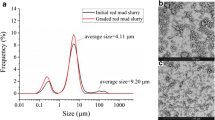Abstract
In order to provide references for selecting highly efficient red mud flocculants, the behaviour of polyacrylamidomethyltrimethyl ammonium chloride (PATAC) in red mud separation process was investigated. PATAC was employed as a flocculant for red mud separation from the caustic aluminate liquor at 95 °C. The used red mud was generated from Chinese diaspore bauxite in Bayer process of alumina production. And the changes of PATAC before or after being treated in caustic solution at 95 °C were studied by thermogravimetry (TG) and Fourier transform infrared (FTIR) spectral analysis. The results show that PATAC fails in effectively flocculating red mud and PATAC is readily converted to a quaternary ammonium hydroxide (PATAH) in caustic solution. PATAH can be decomposed to a new polymer (HPATAH) even at 95 °C. Furthermore, there is an intramolecular hydrogen bond formed in the HPATAH polymer chain with two functional groups of -CH2-OH and -CONH2. Therefore, the poor flocculation property of PATAC for red mud separation can be attributed to the thermal decomposition of PATAC in the caustic red mud slurry at 95 °C and the formation of intramolecular hydrogen bond in the polymer chain of HPATAH during the thermal decomposition, which causes the absorbable functional groups of PATAC to decrease greatly.
Similar content being viewed by others
References
LIU Li-hua, GONG Zhu-qing, ZHENG Ya-jie. Synthesis and structure characterization of diethyldiallylammonium chloride [J]. J Cent South Univ Technol, 2003, 10(4): 347–351.
ROE W J, MALITO J T. Purification of Bayer process liquors: US 4578255 [P]. 1986-08-27.
KOESTER G E. Process for making alumina: EP 0211338A2 [P]. 1987-12-29.
LU Hong-mei, ZHONG Hong, ZHANG Lei, YU Jia-geng, ZENG Xiang-hui. The present situation and prospect of flocculants in red mud settling [J]. Light Met, 2000(9): 23–26. (in Chinese)
BIGGS S, HABGOOD M, JAMESON G J, YAN Y D. Aggregate structures formed via a bridging flocculation mechanism [J]. Chem Eng J, 2000, 80(1): 13–22.
SHUBIN V. Adsorption of cationic polyacrylamide onto monodisperse colloidal silica from aqueous electrolyte solutions [J]. J Colloid Interf Sci, 1997, 191(2): 372–377.
CHVEDOV D, OSTAP S, LE T. Surface properties of red mud particles from potentiometric titration [J]. Colloid Surface A, 2001, 182(2): 131–141.
NASSER M S, JAMES A E. The effect of polyacrylamide charge density and molecular weight on the flocculation and sedimentation behaviour of kaolinite suspensions [J]. Sep Purif Technol, 2006, 52(2): 241–252.
APAK R, TÜTEM E, HÜGÜL M, HIZAL J. Heavy metal cation retention by unconventional sorbents (red muds and fly ashes) [J]. Wat Res, 1998, 32(2): 430–440.
NASSER M S, JAMES A E. Effect of polyacrylamide polymers on floc size and rheological behaviour of kaolinite suspensions [J]. Colloid Surface A, 2007, 301(2): 311–322.
PATIENCE M, ADDAI-MENASH J, RALSTON J. Investigation of the effect of polymer type on flocculation, rheology and dewatering behaviour of kaolinite dispersions [J]. Int J Miner Process, 2003, 71(4): 247–268.
ERSOY B. Effect of pH and polymer charge density on settling rate and turbidity of natural stone suspensions [J]. Int J Miner Process, 2005, 75(3): 207–216.
LU Gui-qian, WU Ding-cai, FU Ruo-wen. Studies on the synthesis and antibacterial activities of polymeric quaternary ammonium salts from dimethylaminoethyl methacrylate [J]. React Funct Polym, 2007, 67(4): 355–366.
GAO Yu, ZHAN Xue-gui, XIE Hong-quan, GAN Zhi-wei. Synthesis and properties of water soluble photosensitive quaternary ammonium hydroxide groups containing phenolic resin [J]. Polym Mater Sci Eng, 2004, 20(1): 65–67. (in Chinese)
WEI Jun-jie. Organic chemistry [M]. Beijing: Higher Education Press, 2003: 290–298. (in Chinese)
DENG Y J, DIXON J B, WHITE G N, LOEPPERT R H, JUO A S R. Bonding between polyacrylamide and smectite [J]. Colloid Surface A, 2006, 281(1): 82–91.
HASINE K, SAADET Ö, MURAT O. Modified polyacrylamide hydrogels and their application in removal of heavy metal ions [J]. Polymer, 2003, 44(6): 1785–1793.
LU Yong-quan, DENG Zhen-hua. Practical infrared spectrum analysis [M]. Beijing: Electronic Industry Press, 1989. (in Chinese)
VASSILEV K, STAMENOVA R, TSVETANOV C. Epoxidation of styrene with hydrogen peroxide in the presence of polymer-supported quaternary ammonium salts and peroxo complexes of W(VI) [J]. React Funct Polym, 2000, 46(2): 165–173.
HU Hui-ping, HUANG Ke-long, PAN Chun-yue. Study on syntheses and characterizations of polymethylphenethylsilane, polymethylcyclohexylsilane and their copolymers [J]. J Cent South Univ Technol, 2000, 7(2): 92–96.
Author information
Authors and Affiliations
Corresponding author
Additional information
Foundation item: Project(2005CB623702) supported by the Major State Basic Research and Development Program of China
Rights and permissions
About this article
Cite this article
Hu, Hp., Zhang, Ky., Zhang, Lj. et al. Thermal decomposition behaviour of polyacrylamidomethyltrimethyl ammonium chloride in red mud separation process. J. Cent. South Univ. Technol. 15, 808–813 (2008). https://doi.org/10.1007/s11771-008-0149-x
Received:
Accepted:
Published:
Issue Date:
DOI: https://doi.org/10.1007/s11771-008-0149-x




